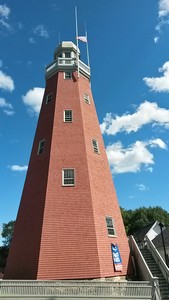 …but not as we know it. And so it was on two occasions in Maine, once in Portland, and again in Prospect. Our visit to
Portland was prompted by the necessity to continue my education in all things American, specifically to go to a minor league
baseball game. Preparation had involved finding a team with a schedule that worked with our travels, discussions on the
similarity to the British childhood game of rounders, albeit on a completely different level if not in the
fundamentals and seeking advice from those in the know about how early to arrive, where to sit, what not to miss etc.
So imagine our disappointment when we arrived to find that the game was sold out. Next time, we'll buy tickets in advance.
…but not as we know it. And so it was on two occasions in Maine, once in Portland, and again in Prospect. Our visit to
Portland was prompted by the necessity to continue my education in all things American, specifically to go to a minor league
baseball game. Preparation had involved finding a team with a schedule that worked with our travels, discussions on the
similarity to the British childhood game of rounders, albeit on a completely different level if not in the
fundamentals and seeking advice from those in the know about how early to arrive, where to sit, what not to miss etc.
So imagine our disappointment when we arrived to find that the game was sold out. Next time, we'll buy tickets in advance.
We decide to make the most of the trip and spend a few hours down on the waterfront where the wharfs are an interesting mix of commercial lobstering and fishing concerns interspersed with yuppified shops, eateries and warehouses converted into upmarket apartments. The moored boats reflect this diversity, lobster boats alongside pristinely white yachts. It's a warm sunny weekend day and the masses, in their summer finery, are out in this trendy enclave. Conspicuous amongst them is a fisherman in his white wellies, jeans and T-shirt covered in crustacean or fish squeezings from his morning's work. The entire area is permeated with a slightly fishy smell and every restaurant advertises its lobster special.
On our way back to the camper we see a sign to an observatory and being interested
in all things celestial, we set off to find it. It's not quite what we expect. In fact it is nothing to do with the stars or
planets. It is a wooden tower in the style of a lighthouse built in
1807 on a slight hill affording views of the sea from the outside balcony encircling the base of the cupola. When a ship was seen
approaching the harbour, flags were flown from the top of the observatory notifying the townspeople of the type of vessel, cargo –
and if an owner had paid a subscription, a specific flag indicating which of his boats was arriving. It is the only remaining
example of what was a fairly common system of maritime signal towers along the coast and is worth a visit not only for the
interesting construction and history but also for the views out across the roofs to the surrounding waters. Misled we may have
been but disappointed we were not.

Nor were we disappointed by the very different observatory
at Prospect that sits alongside Fort Knox which itself is worth a visit but for us was not the main attraction. In 2002, during
rehabilitation work on the bridge across the Penobscot River, fundamental structural problems were revealed,
necessitating the speedy design and construction of a new bridge. Its replacement, the Penobscot Narrows Bridge is a
cable-stayed bridge and at the top of one of its towers is a glass enclosed observation platform accessed by a lift and a
couple of flights of stairs. Stepping out of the lift my stomach lurches at the sight of the river a long way down but my
brain quickly takes over and we climb the rest of the way to the top. In spite of it being a cloudy misty day, the views are
amazing, the river over four hundred feet below, the sea and forested coast stretching off into the distance.
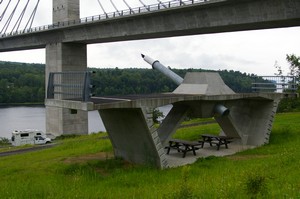
Such views are a real pleasure after weeks in the woodlands of the eastern states where the occasional clearings are created either by the topography or more often by human intervention making way for agriculture or towns. The further north we have travelled this has become increasingly true and nowhere more so than in Maine and New Hampshire.
Sterling has lived in both these states in the past and we're heading for Portsmouth, NH where he used to work. It's a wealthy little city stretching from the coast inland along the banks of the Piscataqua River and is incredibly busy on this weekend afternoon. Sterling is interested to visit one or two of his old haunts some of which are still there even if a little the worse for wear, others gone in the years since we were last here. Portsmouth is a town built around its river crossings and while large old fashioned lift bridges are not uncommon in New Hampshire what is perhaps surprising is that they are still being built, a new one being constructed next to the old one here in the heart of the city.
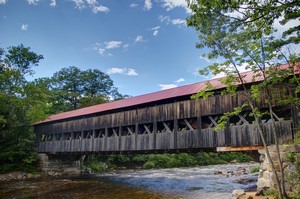 On a much smaller scale but of just as much interest are the wooden covered bridges found in the more rural areas of the state.
They are very much of a bygone era and nothing indicates this more than their height and weight rating: both far too low for the
likes of us. However, when on foot, they still come in handy as rain shelters when caught in an afternoon downpour as we were in
the White Mountain National Forest.
On a much smaller scale but of just as much interest are the wooden covered bridges found in the more rural areas of the state.
They are very much of a bygone era and nothing indicates this more than their height and weight rating: both far too low for the
likes of us. However, when on foot, they still come in handy as rain shelters when caught in an afternoon downpour as we were in
the White Mountain National Forest.
Driving towards and within the National Forest we see frequent road signs requesting us to “Brake for Moose – it could save your life” underneath which is an additional sign “Hundreds of collisions.” In towns we see Moose Tours advertising a ninety eight percent chance of a sighting of these most peculiar looking beasts but in spite of all the warnings and promises we are unlucky and do not see one. We're hoping for something as we travel further north into Canada.
 The White Mountain National Forest deserves its designation covering a massive
1,225 square miles. Its a destination for people, us amongst them, with its mountains, lakes, hiking trails and campgrounds. The
hikes we do in our time here are very much of an ilk; a fairly hard slog going up through dense woodland, opening on to granite
ledges with low-to-the-ground vegetation from where the views make it all worthwhile. The other enticement is the wild blueberries
to be found in the more open sunnier spots and a number of times, we pick enough to carry back for pancakes the next morning. We also
find a plentiful supply the afternoon we take a non-mountain walk from the Passaconaway campground out to Church Pond.
The White Mountain National Forest deserves its designation covering a massive
1,225 square miles. Its a destination for people, us amongst them, with its mountains, lakes, hiking trails and campgrounds. The
hikes we do in our time here are very much of an ilk; a fairly hard slog going up through dense woodland, opening on to granite
ledges with low-to-the-ground vegetation from where the views make it all worthwhile. The other enticement is the wild blueberries
to be found in the more open sunnier spots and a number of times, we pick enough to carry back for pancakes the next morning. We also
find a plentiful supply the afternoon we take a non-mountain walk from the Passaconaway campground out to Church Pond.
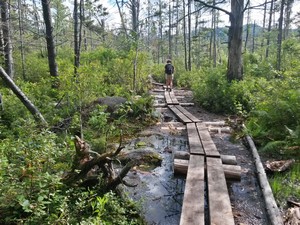 Strangely enough
this turns out to be one of the most interesting of our sorties involving wading across a small river and walking over a considerable
length of bog bridging covered with bear poo at regular intervals.
It's not really a place you'd want to meet a bear although I
suspect the peaty water would be preferable to the alternative if push came to shove. Sterling specialises in taking photos of me
whilst I'm pulling atrocious faces and the one of me
wading the river is no exception. In my defence I can only say that even with
walking sticks, balancing across a rock strewn river bed in water with a reasonably strong current is a serious business requiring
all my concentration.
Strangely enough
this turns out to be one of the most interesting of our sorties involving wading across a small river and walking over a considerable
length of bog bridging covered with bear poo at regular intervals.
It's not really a place you'd want to meet a bear although I
suspect the peaty water would be preferable to the alternative if push came to shove. Sterling specialises in taking photos of me
whilst I'm pulling atrocious faces and the one of me
wading the river is no exception. In my defence I can only say that even with
walking sticks, balancing across a rock strewn river bed in water with a reasonably strong current is a serious business requiring
all my concentration.
The rocks and water on Cannon Cliff high above Profile Lake in Franconia Notch State Park combined over the millennia to produce one
of New Hampshire’s most famous but now non-existent landmarks: The Old Man of the Mountain. A huge rugged profile naturally carved
from the granite, the Old Man became an icon and a symbol of the state. The granite blocks forming his features had long been
threatening to collapse and in spite of many interventions to anchor the stern brow in position, erosion and gravity finally had their
way in 2003 when the visage collapsed wiping his face from the land. His loss was felt so acutely that there has been an attempt
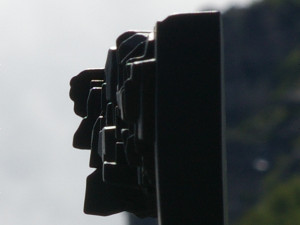 to create the illusion of his continued existence from the Old Man of the
Mountain Profile Plaza a memorial where profiles mounted on poles recreate his outline on the cliff above.
For me, it doesn’t
work but I understand the sentiment; I prefer his memory perpetuated on the state quarters and licence plates. Sterling on the other
hand saw him before his collapse and while he thinks it a little funny that so many people stop for something that is no longer here
he feels that the profiles are quite a clever way to recapture what the old man looked like, especially for those who never got to
see him in the rock.
to create the illusion of his continued existence from the Old Man of the
Mountain Profile Plaza a memorial where profiles mounted on poles recreate his outline on the cliff above.
For me, it doesn’t
work but I understand the sentiment; I prefer his memory perpetuated on the state quarters and licence plates. Sterling on the other
hand saw him before his collapse and while he thinks it a little funny that so many people stop for something that is no longer here
he feels that the profiles are quite a clever way to recapture what the old man looked like, especially for those who never got to
see him in the rock.